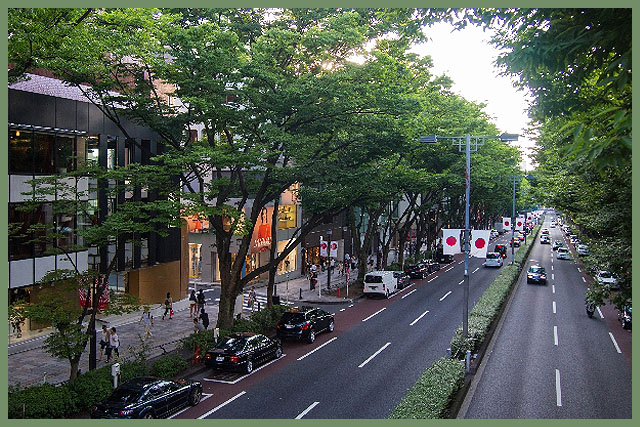https://edoflourishing.blogspot.com/2018/07/udagawa-district-minato-shibuya.html
[ . BACK to DARUMA MUSEUM TOP . ]
. Famous Places and Powerspots of Edo 江戸の名所 .
. Persons and People of Edo - Personen .
::::::::::::::::::::::::::::::::::::::::::::::::::::::::::::::::::::::::::::::::::::::::::::::::::::::::::::::::::::::::::::::::::::::::::::::::::::::::::::::::::::::::::::::::::::
Udagawa choo, Udagawachō 宇田川町 Udagawa district
渋谷区 Shibuya ward, no sub-districts

River Udagawa 宇田川 can not be seen from this district.
It used to be a small shopping district of Tokyo, but recently many highrise buildings were erected.
The name might refers to a retainer of the Hojo clan
宇田川和泉守長清 Udagwa Izumi no Kami Nagakiyo
who had his estate in this area.
In 1590, Toyotomi Hideyoshi defeated the Hojo in Odawara and Hojo Ujimasa killed himself.
Later Udagawa in Edo became the head man of a district named after him.
.......................................................................

River 宇田川 Udagawa is a tributary of the river 渋谷川 Shibuyagawa.
In a print by 長谷川雪旦 Hasegawa Settan, Yoyogi Hachimangu, there is a Shinto shrine on a hill, with the river Udagawa running below.
In the Edo period, there was a bridge, 五石橋 Goseki-Kyo over the river.
(Now this is around 神山町5番 Kamiyama, fifth sub-district.
It flowed into the Shibuyagawa close to Shibuya station, at the bridge 宮益橋 Miyamasubashi.
The Udagawa River is a tributary of the Shibuya River. Though now a culvert, its name lives on -- the district north of JR Shibuya Station is called Udagawacho. The Shibuya River used to flow round an elevated area, which was to the right of the land depicted in the print -- and which encompasses what are now Yoyogi Park and Meiji Shrine. Today it runs along part of Meiji-dori near Ebisu Station and then on into Tokyo Bay.
. Yoyogi Hachimangu 代々木八幡宮 .
::::::::::::::::::::::::::::::::::::::::::::::::::::::::::::::::::::::::::::::::::::::::::::::::::::::::::::::::::::::::::::::::::::::::::::::::::::::::::::::::::::::::::::::::::::
- Not related -
. Udagawa Yōan 宇田川榕菴 Udagawa Yoan (1798 - 1846) .
a 19th-century Japanese scholar of Western studies, or "Rangaku".
Tsuyama Archives of Western Learning 津山洋学資料館
The origin of the Chinese characters for coffee 珈琲
Mead, Mede in the Edo Period in Japan ミード / 蜂蜜酒
::::::::::::::::::::::::::::::::::::::::::::::::::::::::::::::::::::::::::::::::::::::::::::::::::::::::::::::::::::::::::::::::::::::::::::::::::::::::::::::::::::::::::::::::::::

- - - To join me on facebook, click the image !
:::::::::::::::::::::::::::::::::::::::::::::::::::::::::::::::::::::::::::::::::::::::::::::::::::::::::::::::::::::::::::::::::::::::::::::::::::::::::::::::::::::::::::::::::::::
. Shibuya ku 渋谷区 Shibuya ward .
. Edo bakufu 江戸幕府 The Edo Government .
. Famous Places and Powerspots of Edo 江戸の名所 .
. Doing Business in Edo - 商売 - Introduction .
. shokunin 職人 craftsman, craftsmen, artisan, Handwerker .
. senryu, senryū 川柳 Senryu poems in Edo .
. Japanese Architecture - The Japanese Home .
. Interior Design - The Japanese Home .
. Legends and Tales from Japan 伝説 - Introduction .
[ . BACK to DARUMA MUSEUM TOP . ]
[ . BACK to WORLDKIGO . TOP . ]
- - - - - #udagawa #udagawadistrict - - - -
::::::::::::::::::::::::::::::::::::::::::::::::::::::::::::::::::::::::::::::::::::::::::::::::::::::::::::::::::::::::::::::::::::::::::::::::::::::::::::::::::::::::::::::::::::
Udagawa district Minato Shibuya
. Famous Places and Powerspots of Edo 江戸の名所 .
. Persons and People of Edo - Personen .
::::::::::::::::::::::::::::::::::::::::::::::::::::::::::::::::::::::::::::::::::::::::::::::::::::::::::::::::::::::::::::::::::::::::::::::::::::::::::::::::::::::::::::::::::::
Udagawa choo, Udagawachō 宇田川町 Udagawa district
渋谷区 Shibuya ward, no sub-districts

River Udagawa 宇田川 can not be seen from this district.
It used to be a small shopping district of Tokyo, but recently many highrise buildings were erected.
The name might refers to a retainer of the Hojo clan
宇田川和泉守長清 Udagwa Izumi no Kami Nagakiyo
who had his estate in this area.
In 1590, Toyotomi Hideyoshi defeated the Hojo in Odawara and Hojo Ujimasa killed himself.
Later Udagawa in Edo became the head man of a district named after him.
.......................................................................

River 宇田川 Udagawa is a tributary of the river 渋谷川 Shibuyagawa.
In a print by 長谷川雪旦 Hasegawa Settan, Yoyogi Hachimangu, there is a Shinto shrine on a hill, with the river Udagawa running below.
In the Edo period, there was a bridge, 五石橋 Goseki-Kyo over the river.
(Now this is around 神山町5番 Kamiyama, fifth sub-district.
It flowed into the Shibuyagawa close to Shibuya station, at the bridge 宮益橋 Miyamasubashi.
The Udagawa River is a tributary of the Shibuya River. Though now a culvert, its name lives on -- the district north of JR Shibuya Station is called Udagawacho. The Shibuya River used to flow round an elevated area, which was to the right of the land depicted in the print -- and which encompasses what are now Yoyogi Park and Meiji Shrine. Today it runs along part of Meiji-dori near Ebisu Station and then on into Tokyo Bay.
. Yoyogi Hachimangu 代々木八幡宮 .
::::::::::::::::::::::::::::::::::::::::::::::::::::::::::::::::::::::::::::::::::::::::::::::::::::::::::::::::::::::::::::::::::::::::::::::::::::::::::::::::::::::::::::::::::::
- Not related -
. Udagawa Yōan 宇田川榕菴 Udagawa Yoan (1798 - 1846) .
a 19th-century Japanese scholar of Western studies, or "Rangaku".
Tsuyama Archives of Western Learning 津山洋学資料館
The origin of the Chinese characters for coffee 珈琲
Mead, Mede in the Edo Period in Japan ミード / 蜂蜜酒
::::::::::::::::::::::::::::::::::::::::::::::::::::::::::::::::::::::::::::::::::::::::::::::::::::::::::::::::::::::::::::::::::::::::::::::::::::::::::::::::::::::::::::::::::::

- - - To join me on facebook, click the image !
:::::::::::::::::::::::::::::::::::::::::::::::::::::::::::::::::::::::::::::::::::::::::::::::::::::::::::::::::::::::::::::::::::::::::::::::::::::::::::::::::::::::::::::::::::::
. Shibuya ku 渋谷区 Shibuya ward .
. Edo bakufu 江戸幕府 The Edo Government .
. Famous Places and Powerspots of Edo 江戸の名所 .
. Doing Business in Edo - 商売 - Introduction .
. shokunin 職人 craftsman, craftsmen, artisan, Handwerker .
. senryu, senryū 川柳 Senryu poems in Edo .
. Japanese Architecture - The Japanese Home .
. Interior Design - The Japanese Home .
. Legends and Tales from Japan 伝説 - Introduction .
[ . BACK to DARUMA MUSEUM TOP . ]
[ . BACK to WORLDKIGO . TOP . ]
- - - - - #udagawa #udagawadistrict - - - -
::::::::::::::::::::::::::::::::::::::::::::::::::::::::::::::::::::::::::::::::::::::::::::::::::::::::::::::::::::::::::::::::::::::::::::::::::::::::::::::::::::::::::::::::::::


































